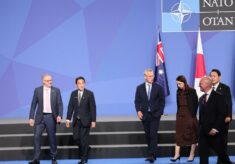On the 5th of May, in the frame of a “war economy” Commissioner Breton announced, as a matter of high priority, the proposal for a new Regulation named ASAP – Act in Support of Ammunition Production (the Act in the text); it is the third track of the EU’s interlinked and parallel three-track pronged approach for Ukraine proposed by Borrell and agreed by the Council.
The Act is unprecedented; it will urgently mobilize the EU budget, both to reinforce industrial capacities for production ramp-up of “relevant defence products meaning ground-to-ground and artillery ammo as well as missiles”, including components, and to urgent adapt the EU defence ecosystem to a structural change. Von Der Leyen states that it is a coherent set of measures that “will help member states to ramp up the production… and speed up the delivery of ammunition to meet Ukraine’s and member states’ needs”.
The EC rationale reads: “In order to address those market disruptions, the Act includes several emergency and temporary regulatory measures designed to restore a smooth functioning of the Internal Market, hence enabling a speedy and longer-term availability of ammunition and missiles.”
It is interesting to understand the reasons to justify the Act. EC recognizes that the functioning of EDTIB does not follow the conventional rules and business models. Industry self-funding is activated only as a consequence of firm orders. In the current supply crisis, EU needs to act on the supply side by de-risking industrial investments for removing bottlenecks and faster adaptation to structural market changes.
The increased need to ramp up defence industry production capacity especially of ammo and replenish equipment stocks is under discussion also within NATO, as well as procurement guidelines and production targets. There are expectations for endorsement, at next Vilnius summit, of a new NATO Defence Production Action Plan to ensure that NATO continues to have the capabilities it needs.
It is remarkable to see the wide involvement of EU States in supporting associable EU member States such as Ukraine, Moldovia and Georgia – a sign of a more assertive foreign policy – by making use of separated instruments, as a result of the complexity of EU mechanics, but also the implication of all its organizations. A political momentum for the European defence is there. In fact, the Act is the final result of a work started in 2020 by the Joint Defence Task Force identifying the most critical shortfalls, followed by the EDA set up in record time of the Collaborative Procurement of Ammunition and the March signature by 24 States of the project arrangement.
The Council framework opens the way to the design and fast-track – by-passing lengthy procedures – new measures on defence in order to enable States to refill their stocks and continue supporting Ukraine.
In a nutshell (key words are urgency, temporary, supply chain, security of supply, Internal Market functioning):
The “defence procurement context” in the EU is a multi-layered step, out of the EU budget. Military procurement is performed through the off-the-shelf European Peace Facility instrument, spanning from general equipment to ammunition.
The Act is not about procurement of military equipment. It is about a temporary set of financial incentives for reinforcing and ramping up European production capacities, like the CHIPS IPCEI, facilitating industrial partnerships along the supply chain in specific fields. That’s why it is drafted in a prudent and subtle language.
The Act is a new, fast-track, urgent, temporary process limited in scope, not prejudging national competencies nor EU competition rules. It is a narrow path with a strong political support by Member States and EU, that could be a precursor for next EDIP (European Defence Industrial Program).
The approach taken by Breton in the Act includes new interesting elements balancing prudence and novelties, having in mind different national sensitivities and an effort to “break” traditional principles, taboos and obstacles in the EU context.
Supply chain. The Act promotes the EDTIB value chain and the reduction of disruptions along the supply chain, including flexibility in case of urgent needs, by considering no geographical restrictions on the origin of suppliers (the example provided concerns powder manufacturing), thus avoiding contentious issues such as defining “European company” and Strategic Autonomy.
Money for the Act is not new, 513€ should be transferred from MFF, EDF and EDIRPA. This implies a cut in R&D (which EDF projects?) and in joint procurement (as such marginalizing EDIRPA). New money would have raised criticisms inside the EU, due to Treaties limits on military spending; more, EU financial rules allow new commitments only at the mid-term-review of the 7-year financial budget or in case of unspent yearly funds.
Mobilization of EU financial instruments includes several options. Co-financing (up to 60% for direct costs plus bonuses and a small 7% fat rate for indirect costs) is an EU fundamental principle, allowing EU to play a subsidiarity role in supporting and incentivizing its economic sectors.
The Act introduces the option for States to mobilize existing EU financial instruments, by applying their National Recovery and Resilience Plans – military production falls with its resilient objectives – as well as the Cohesion Fund within its remit – seen controversial by some Nations – by addressing a major critical issue faced by companies in the EU, meaning the lack of enough skills in defence.
Another option relates to the EU sustainable finance network which does not prevent investment in defence initiatives. EC assumes that a commitment by National Promotional Banks and Institutions would send a strong signal to private investors.
The Act also hopes that European Investment Bank, where unanimity is needed to allow its lending policies to cover defence, “should enhance its support to defence beyond its ongoing support to dual-use.” A debate started long ago.
The Act also explores the appropriate way to leverage EU budget unlock private or public investment in support of a blending investment facility or Ramp-up fund, under InvestEU, to support increased capacities in ammo and missiles. EC seems to be taking stock of a previous initiative with stakeholders with the object of designing new EU tools for defence.
A temporary regulatory pillar entails interesting (and cautious) waiver measures for scaling up current obstacles, better functioning of the Internal Market and guaranteeing the Security of Supply. Namely, limited derogations to 2009/81 and 2009/43 defence Directives in terms of smoothing authorization procedures, speed up national administrative processes such as certification, opening of existing framework agreements to other States. The Act introduces a complex legal issue on the prioritization of rated orders with appropriate guarantees, such as an exemption for any liabilities of damages for the violation of contractual obligations, since an EC decision on priority order has precedence over them.
It remains to been to what extent these measures will be effectively pursued by Nations.
Fabrizio Braghini
Fabrizio Braghini is a European and defence policies analyst. He has worked for decades in Finmeccanica, now Leonardo SpA, the prime Italian defence industrial conglomerate.






























